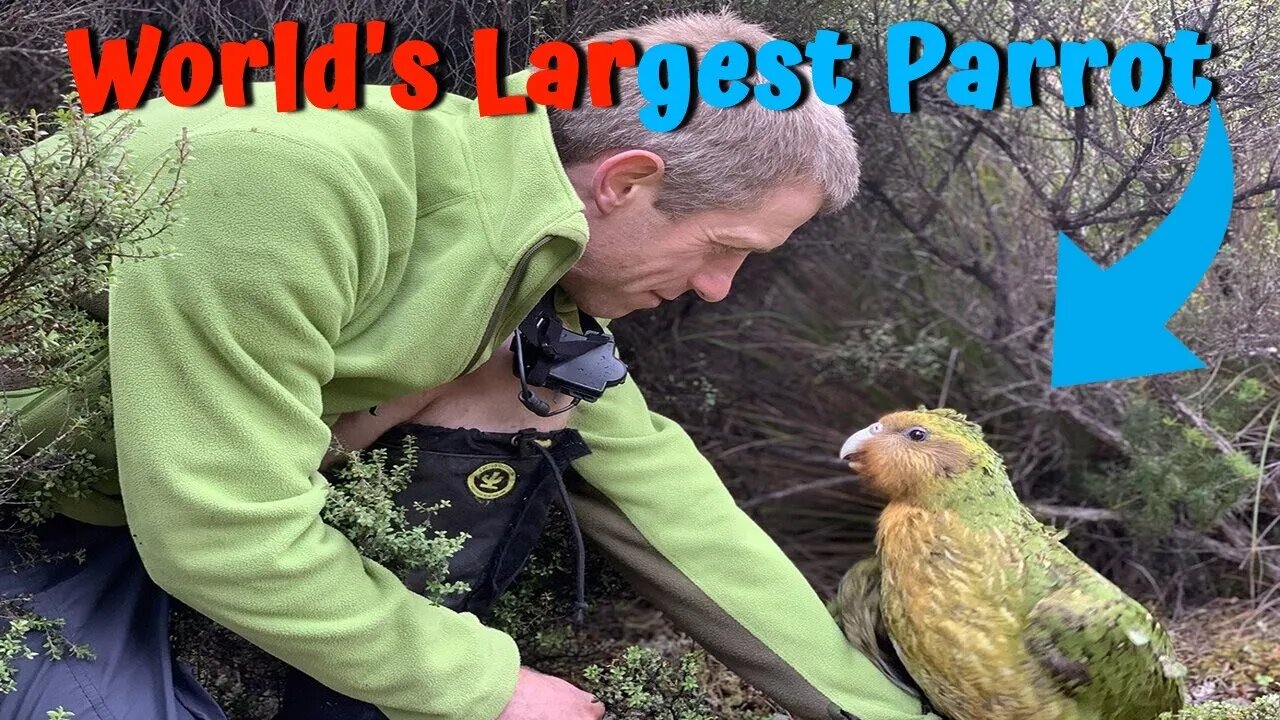Premium Only Content

World's Largest Parrot (Kakapo)
The kakapo, also known as hunting, is a species of nocturnal parrot, endemic to New Zealand, these parrots are also unable to fly. The kakapo is a critically endangered bird. In 2013, the population had only 124 birds. In 2017, there was a slight increase, to 154 specimens. Its common name means night parrot in Maori. The kakapo is a robust parrot that can measure up to 60 cm in length and weigh between 3 to 4 kg. The wings are stunted and small and only serve as a swing when these birds circulate between tree branches. Kakapos have feathers on their beaks, which serve as sensory whiskers and allow them to better recognize their surroundings at night, their period of activity, these birds also have a very keen sense of smell. Kakapos are herbivorous birds that feed on various species native to New Zealand, consuming seeds, fruits and pollen. Its favorite food source is the fruit of the rimu, a tree endemic to its habitat. Occasionally, kakapo may also feed on insects and other small invertebrates. The kakapo's plumage provides good camouflage against the native vegetation and is in shades of dry green, streaked with black on the dorsal area, while the ventral area and throat are yellowish in color. As they do not have stiff flight feathers, kakapos have very soft and smooth plumage. The kakapos have a unique reproductive strategy, in the breeding season, males abandon their territories to take possession of a kind of arena, where they perform elaborate displays, designed to attract the greatest possible number of females. The favorite places for these exhibitions are the tops of hills or escarpments and the males fight among themselves for the most favorable locations. Inside their arena, which can be up to 7 km long, each male digs countless holes in the ground, next to trees or rocks, about half a meter in diameter and 10 cm deep. During the period of nocturnal activity, the male travels through these numerous holes, using each one as a stage to emit noisy low-frequency vocalizations that can be heard from about 1 km away. The females hear the vocalizations of the various males and eventually make their choice, heading to the corresponding arena. Copulation occurs after a brief display by the male before the female and after the encounter both separate and return to their activities. Kakapo females lay between 1 and 4 eggs per lay, the incubation period lasts about 30 days, the juveniles hatch without feathers and are totally dependent on their female. Juveniles become more or less independent at about 10 to 12 weeks, although the mother may continue to feed them for the next six months. The sexual maturity of males occurs at 5 years of age and that of females between 9 and 11 years. Under normal conditions, kakapo can live up to 60 years.
#kakapo #NaturalWorld!
-
 1:44:46
1:44:46
PandaSub2000
9 hours agoUltimate Chicken Horse | ULTRA BEST AT GAMES (HD Edited Replay)
1.13K -
 1:47:16
1:47:16
omarelattar
2 days agoTroy Eckard Shares His Rags to Riches Story
1.59K -
 26:18
26:18
GritsGG
12 hours agoHow to Activate Heat Map & Find Self Revives On Warzone!
1.33K -
 29:01
29:01
The Pascal Show
1 day ago $7.74 earnedRUNNING SCARED! Candace Owens DESTROYS TPUSA! Are They Backing Out?!
34.2K36 -
 24:45
24:45
Blabbering Collector
1 day agoUnboxing The 2025 Diagon Alley Advent Calendar By Carat Shop | Harry Potter
1.58K -
 0:43
0:43
Gaming on Rumble
1 day ago $5.40 earnedLvl UP (Raids)
34K2 -
 LIVE
LIVE
Lofi Girl
2 years agoSynthwave Radio 🌌 - beats to chill/game to
932 watching -
 19:07
19:07
MetatronGaming
1 day agoWe need to find a way out NOW!
3.04K -
 1:11:16
1:11:16
omarelattar
4 days agoHow I Went From Depressed w/ $0 To $500 Million Per Year In My 20's (COMFRT CEO Hudson Leogrande)
3.96K -
 2:22:42
2:22:42
Badlands Media
22 hours agoDevolution Power Hour Ep. 413 – The J6 Narrative Cracks, Media Meltdowns, and the Intel Nobody Trusts
227K33